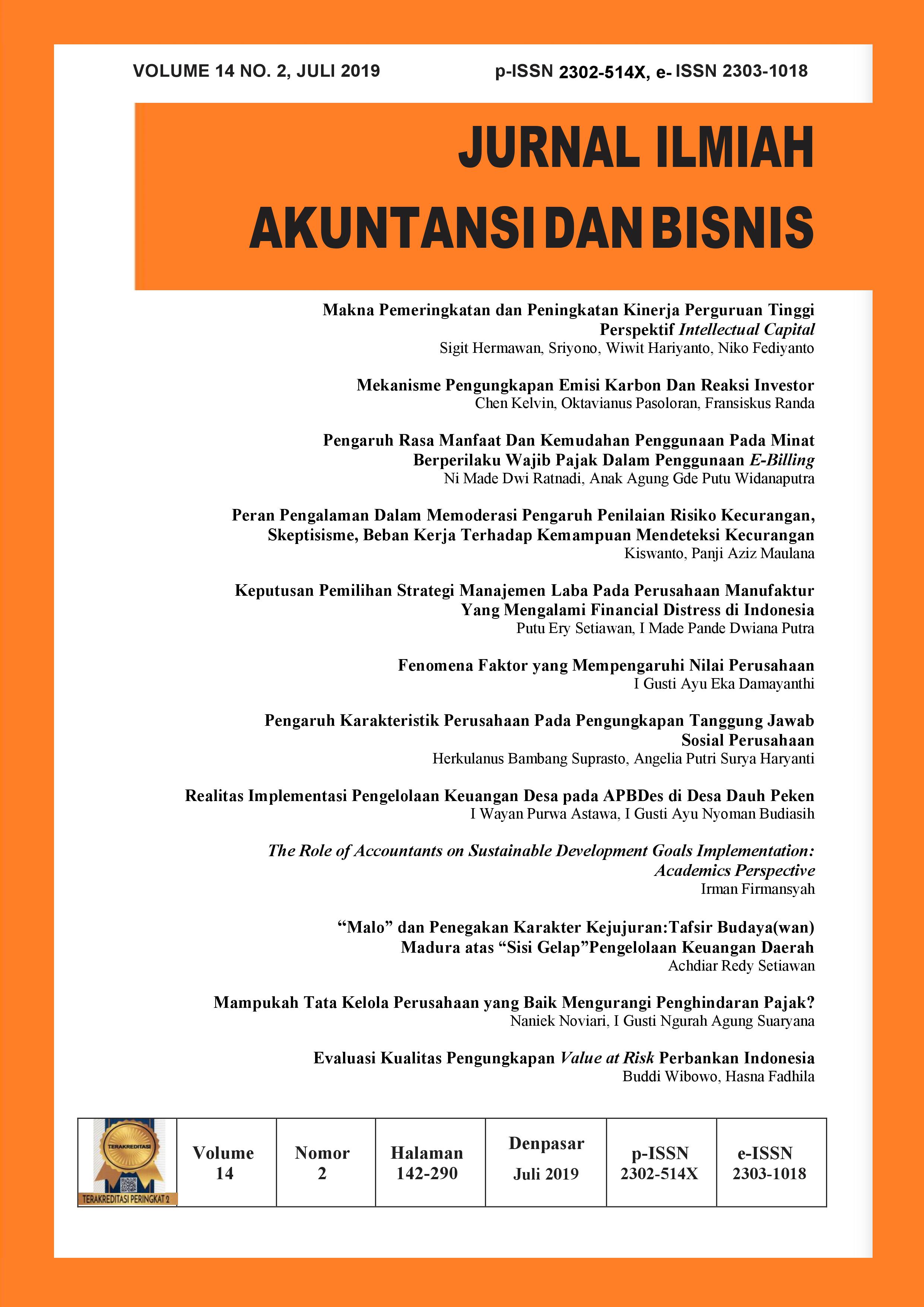Pengaruh Persepsi Kegunaan, Kemudahan Penggunaan dan Norma Subyektif pada Minat Berperilaku Penggunaan E-Billing
Abstract
This study aims to examine the behavior of individual taxpayers that use e-billing. The study was conducted at the Primary Tax Office in the Province of Bali. Data was collected using surveys. The sample was selected using convenience non-probability sampling technique. The number of respondents analyzed was 120 people. A variance based structural equation modeling approach with the calculation process supported by the partial least square was used in data analysis. The results show that perceived usefulness has a positive effect on attitude toward using e-billing, ease of use has a positive effect on attitude toward e-billing, ease of use has a positive effect on the perceived usefulness. The attitude and subjective norms positively influence the interest of individual taxpayers in using the e-billing system in paying taxes.
Keyword: E-billing, perceived ease of used, usefulness, attitude
Downloads
References
Ajzen, I. (1988). from intentions to actions: attitudes, personality, & behavior. Dorsey Press.
Ajzen, I., & Fishbein, M. (1970). The prediction of behavior from attitudinal and normative beliefs. Journal of Experimental Social Psychology, 6, 466–487. https://doi.org/10.1016/0022-1031(70)90057-0
Ajzen, I., & Fishbein, M. (1980). Understanding attitudes and Predicting Social Behavior. NJ: Prentice Hall. New Jersey.
Arthana, Y. W., & Rukhviyanti, N. (2015). Pengaruh Minat Individu Terhadap Penggunaan Mobile Banking (M-Banking): Model Kombinasi Technology Acceptance Model (TAM) dan Theory Of Planned Behaviour (TPB). Jurnal Informasi, 7(1).
Bashir, I., & Madhavaiah, C. (2015). Consumer attitude and behavioural intention towards Internet banking adoption in India. Journal of Indian Business Research, 7(1), 67–102.
Chen, C., & Tsai, D. (2007). How Destination Image and evaluative factors affect behavioral intentions. Tourism Management.
Chin, W. W., & Todd, P. A. (1995). On the Use, Usefulness, and Ease of Use of Structural Equation Modeling in MIS Research: A Note of Caution. MIS Quarterly, 19, 237–246.
Davis, F. D. (1993). User Acceptance of Information Technology: System Characteristics, User Perceptions and Behavioral Impacts. International Journal of Man-Machine Studies, 38(3), 475–487.
Davis, F. S. (1989). Perceived Usefulness, Perceived Ease of Use, and User Acceptance of Information Technology. MIS Quarterly, 13(3), 319–340.
Goodhue, D. L., & Thompson, R. L. (1995). Task Technology Fit and Individual Performance. MIS Quarterly, 19(2), 213–236.
Igbaria, M., Zinatelli, N., Cragg, P., & Cavaye, A. L. M. (1997). Personal Computing Acceptance Factor in Small Firms: A Structural Equatiion Model. MIS Quarterly, 21(3), 279–305.
Jogiyanto. (2007). Sistem Informasi Keperilakuan. Andi Offset.
Laihad, R. C. Y. (2013). Pengaruh Perilaku Wajib Pajak terhadap Penggunaan E-Filing Wajib Pajak di Kota Manado. Jurnal EMBA, 1(3), 44–51.
Mas’ud, M. H. (2012). Pengaruh Sikap, Norma-Norma Subyektif dan Kontrol Perilaku Yang Dipersepsikan Nasabah Bank Terhadap Keinginan Untuk Menggunakan Automatic Teller Machine (Atm) Bank Bca di Kota Malang. Jurnal Manjemen Dan Akuntansi, 1(28), 13–28.
Nasri, W., & Lanouar, C. (2012). Factors Affecting the Adoption of Internet Banking in Tunisia: Theory of Acceptance Model and Theory of Planned Behavior. Journal of High Technlogy Management Research, 23, 1–14.
Nurhasanah, Firmansyah, & Novrida. (2015). Pengaruh Persepsi Wajib Pajak Orang Pribadi terhadap Penggunaan E-Filing di KPP Pratama Palembang Ilir Barat. Jurnal Akuntanika, 1(1).
Nysveen, H., Pedersen, P. E., & Thorbjørnsen, H. (2005). Explaining intention to use mobile chat services: Moderating effects of gender. Journal of Consumer Marketing, 22(5), 247–256.
Peterson, J. L. (2003). Oral and Maxillofacial Surgery. C.V Mosby Company.
Rahyuda, K. (2016). Metode Penelitian Bisnis. Udayana University Press.
Ratnaningrum, L. P. R. A. (2013). Aplikasi Model TAM Terhadap Pengguna Layanan Internet Banking di Kota Denpasar.
Rysaka, N., Saleh, C., & Rengu, S. . (2013). Penerapan Sistem Elektronik dalam Pelayanan Perpajakan (Studi pada Kantor Pelayanan Pajak Pratama Malang Utara). Jurusan Akuntansi Publik (JAP), 2(3), 420–425.
Saad, N. (2014). Tax Complexity and Tax Compliance: Taxpayers View. Procedia-Social and Behavioral Sciences, 109, 1069–1075.
Segars, A. H., & Grover, V. (1993). Re-examining Perceived Ease of Use and Usefulness: A Confirmatory Factor Analysis. MIS Quarterly, 18(4), 517–525.
Sekaran, U. (2006). Research Method for Business. John Wiley & Sons,Inc, 160.
Solimun. (2002). Multivariate Analysis Structural Equation Modelling (SEM) Lisrel dan Amos. Fakultas MIPA, Universitas Brawijaya.
Subramanian, G. H. (1994). A Replication of Perceived Usefulness and Perceived Ease of Use Measurement. Decision Sciences, 25(6), 863–874.
Susanto, N. . (2011). Analisis Perilaku Wajib Pajak terhadap Penerapan Sistem E-Filing Direktorat Jenderal Pajak. Universitas Indonesia.
Szajna, B. (1996). Empirical Evaluation of The Revised Technology Acceptance Model. Informs Pubs Online Management System, 42(1), 85–92.
Taylor, S., & Todd, P. A. (1995). Understanding Information Technology Usage: A Test of Competing Models. Information System Research, 6, 144–176.
Venkatesh, V., & Moris, M. G. (2000). Why Don’t Men Ever Stop to Ask for Directions? Gender, Social Influence, and Their Role in Technology Acceptance and Usage Behavior. MIS Quarterly, 24(1).
Venkatesh, V., Morris, M. G., & Ackerman, P. L. (2000). A Longitudinal Field Investigation of Gender Differences in Individual Technology Adoption Decision-Making Processes, 83(1), 33–60. https://doi.org/10.1006/obhd.2000.2896
Zadeh, S. ., Ayub, A. F. ., Mahmud, R., & Daud, S. . (2014). Behavior Intention to Use of Learning Management System among Malaysian Pre-Service Teachers: A Confirmatory Factor Analysis. International Journal of Education & Literacy Studies, 2(1), 29–39.




















